This is the ultimate guide to Dashi, Japanese soup stock. You’ll learn about the different types of dashi, the ingredients, and how each stock is used in Japanese cooking.
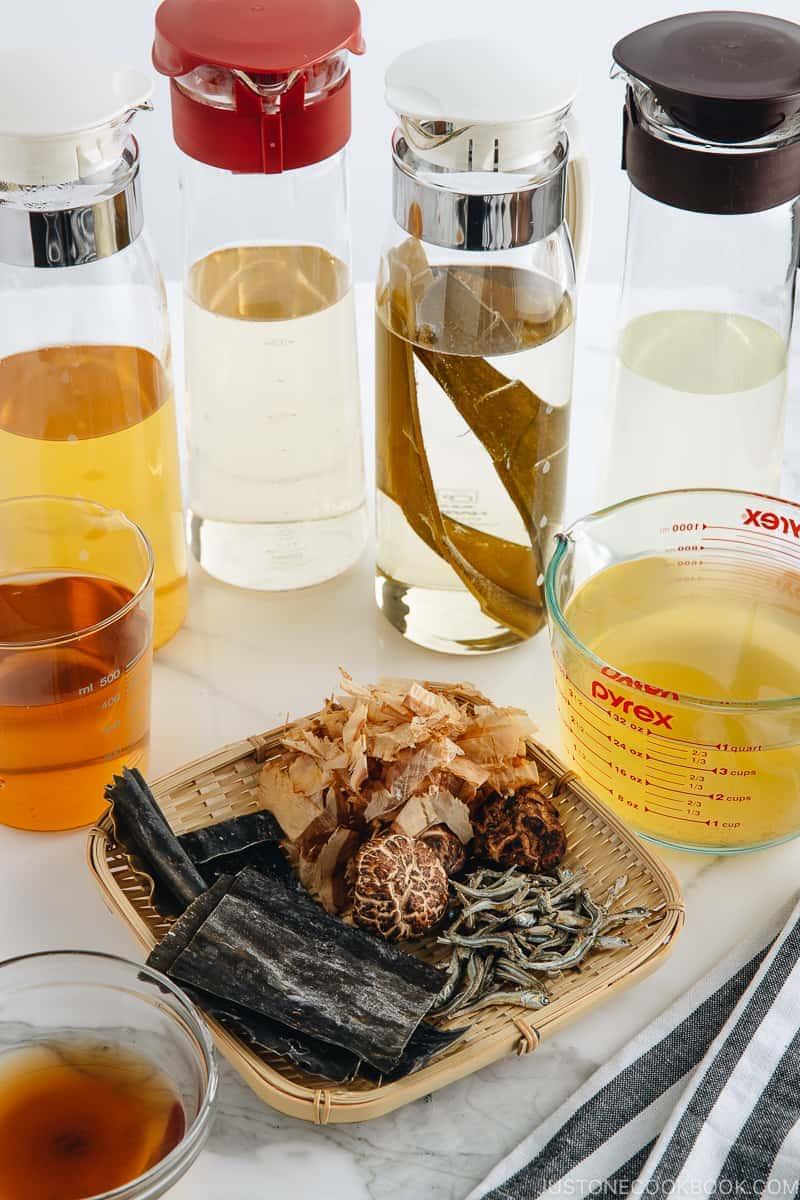
What is Dashi?
Dashi (だし, 出汁) or Dashijiru (出し汁) is Japanese soup stock that is the backbone of many Japanese dishes. It is all-important and indispensable, and you can trace its existence in Japanese daily cooking back to the Edo period (17th Century).
Unlike soup stocks from other cuisines, which are typically made by boiling an assortment of meat, vegetables, herbs, and spices for several hours, dashi usually contains only one or two ingredients, and preparation takes just 20 minutes. Yet, dashi gives Japanese food its unique, rich, umami-packed savory flavor.
The Japanese soup stock is often made from:
- Kombu (dried kelp)*
- Katsuobushi (dried bonito flakes)
- Iriko or niboshi (dried anchovies/sardines)
- Shiitake (dried shiitake mushrooms)*
- OR a combination of all above or two (such as kombu + katsuobushi)
*vegetarian and vegan
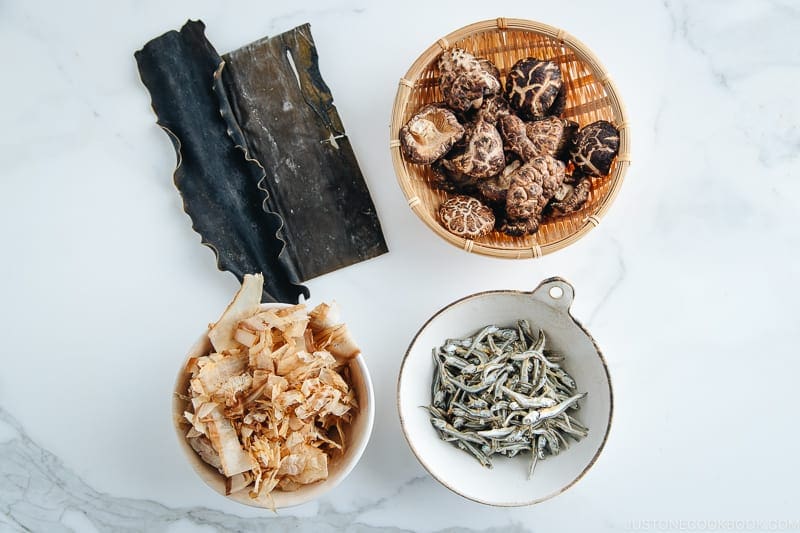
How Does Dashi Taste Like?
All the dried ingredients that are used to make Japanese soup stock are rich in naturally occurring glutamates and provide intense flavor to the stock. Dashi creates a savory umami flavor from all these ingredients and you don’t need to season the food as much once you have a good stock.
With a distinctive sweet and savory note, the deep umami flavor is what set dashi apart from other stocks.
How Do You Use Dashi in Cooking?
The most common use for Japanese soup stock is in a bowl of delicious miso soup, the soup for the soul for the Japanese. If you wish to make a bowl of authentic Japanese miso soup, I strongly encourage you to use dashi instead of substituting it with other broths such as vegetable or chicken broth. You will notice the difference right away!
Dashi is also being used as a broth base in Japanese hot pots (e.g., Shabu Shabu), stews (e.g., Oden), simmered dishes (e.g., Nikujaga), and noodle soup dishes (e.g., udon, soba, and ramen).
You can also use it as a seasoning liquid (e.g, Tamagoyaki, Takikomi Gohan, and Takoyaki) or add it to sauces to bring out the savory depth of the dishes. Since it is a clear umami-rich broth with a subtle aroma, dashi is really versatile and you can literally use it in any dish that call for a touch of liquid.
6 Different Types of Dashi
A lot of people think dashi is made of fish, so vegetarians and vegans can’t use it. No, that’s not true.
There are 5 different types of dashi and I’ll introduce them here. How do we decide which stock to use for a particular dish? Well, there is no rule and it’s up to you. Below, I added some examples of dishes that go well with each type of dashi.
Classic Awase Dashi (Kombu and Katsuo Dashi)
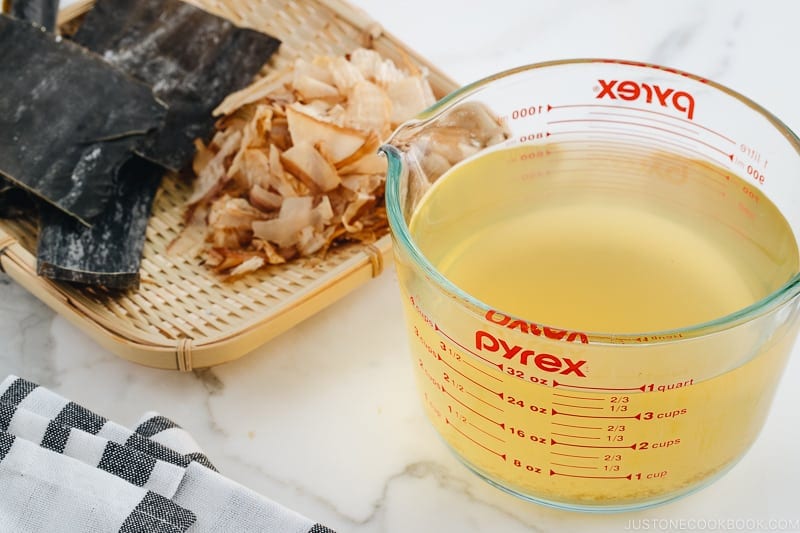
- Awase dashi (合わせだし) is a combination of kombu (dried kelp)and katsuobushi (dried bonito flakes).
- The most common, all-purpose seafood-based stock (and this is my go-to stock).
- Awase means “combination” or “mixed” in Japanese.
- This is my go-to dashi for my recipes.
? RECIPE: To make it from scratch, check out How To Make (Awase) Dashi.
This stock is good for:
- Miso Soup
- Oyakodon
- Oden
- Nikujaga
- Chikuzenni
- Tamagoyaki, etc.
Kombu Dashi
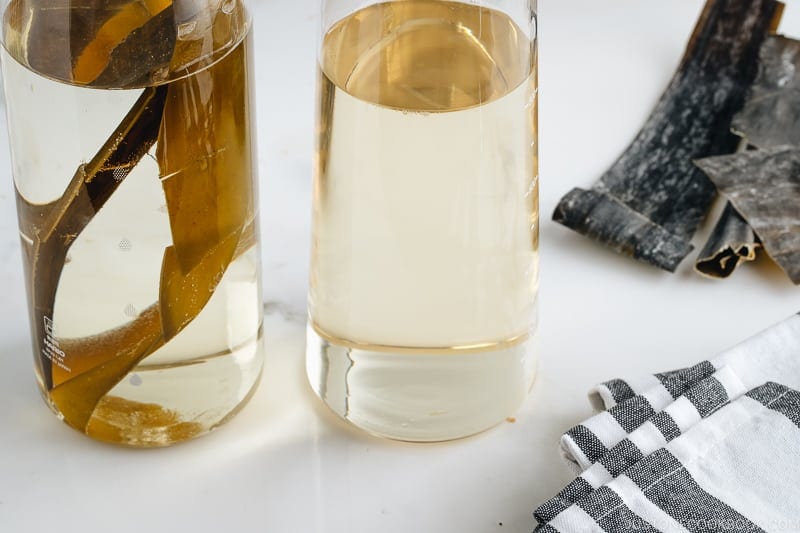
- Kombu dashi (昆布だし) is a vegetarian/vegan stock made from kombu (dried kelp).
- Gentle flavor.
- It’s probably the easiest stock to make.
? RECIPE: To make it from scratch, check out How To Make Kombu Dashi.
This stock is good for:
- Yudofu
- Clam Soup
- Shabu Shabu
- Vegetable Ohitashi
- Use when the flavor of other ingredients is subtle and when the main ingredient is fish or seafood.
Katsuo Dashi
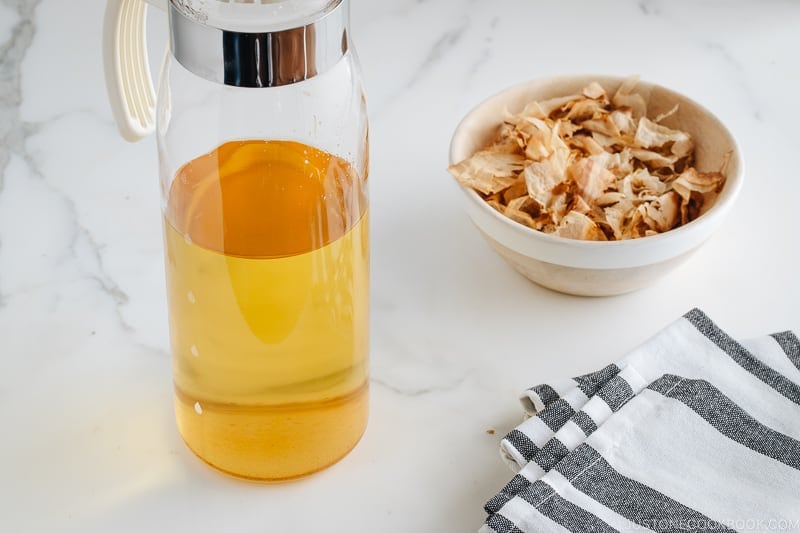
- Katsuo dashi (鰹だし) is a seafood-based stock made from katsuobushi (dried and fermented skipjack tuna/bonito that is shaved into thin flakes).
- Aromatic, flavorful, and elegant.
? RECIPE: To make it from scratch, check out How To Make Katsuo Dashi.
This stock is good for:
- Clear Soup
- Chawanmushi
- Vegetable Ohitashi
- Noodle soup dishes (e.g., Okinawa Soba)
- Simmered dishes
- Great for vegetables, but not recommended for fish dishes
Iriko Dashi (Niboshi Dashi)
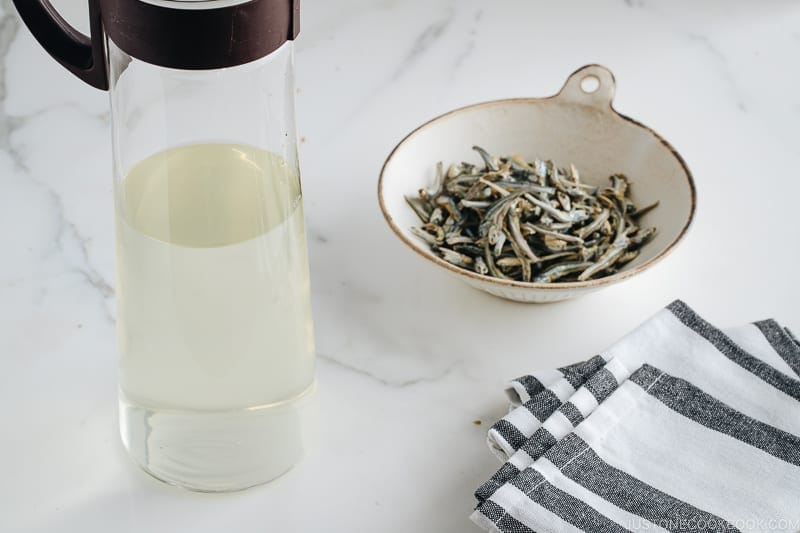
- Iriko (Niboshi) dashi (いりこだし・煮干しだし) is a seafood-based stock made from iriko / niboshi (dried baby anchovies/sardines).
- Strong fishy aroma and taste.
- Most affordable compared to kombu and katsuobushi.
? RECIPE: To make it from scratch, check out How To Make Iriko Dashi.
This stock is good for:
- Miso Soup (most commonly used)
- Noodle soup dishes (Curry Udon, Kitsune Udon, etc) and Mentsuyu
- Donburi (rice bowl) dishes
- Simmered dishes (Simmered Kabocha)
- Use it when you want a nice savory stock to go with other strong distinct flavors or seasoning like soy sauce, but don’t use it to cook fish because the overall result could come out too strong.
Shiitake Dashi
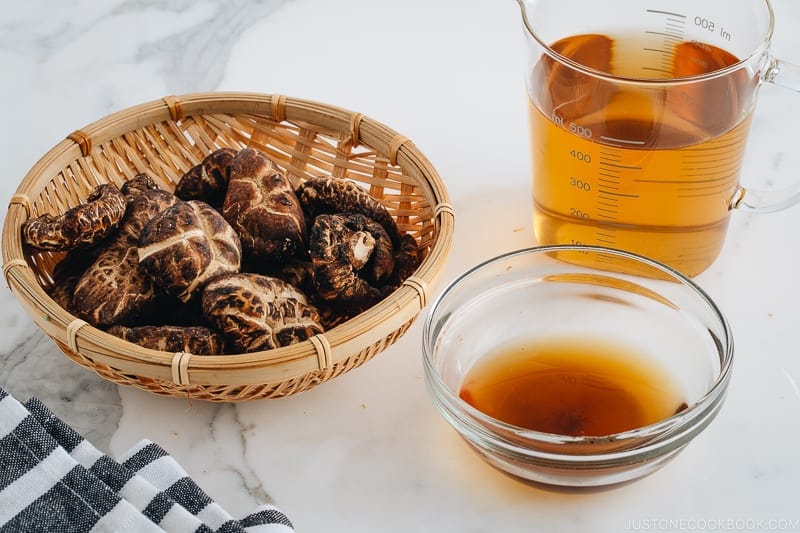
- Shiitake dashi (干し椎茸の戻し汁・椎茸だし) is a vegetarian/vegan stock made from rehydrating dried shiitake mushrooms.
- Rehydrated shiitake is used for cooking.
- The soaking liquid (Shiitake Dashi) is rarely used as its own and is usually combined with Kombu Dashi or Katsuo Dashi to enhance the flavor.
? RECIPE: To make it from scratch, check out How To Make Shiitake Dashi.
This stock is good for:
- Takikomi Gohan
- Chawanmushi
- Noodle soup dishes (Nabeyaki Udon, etc)
- Simmered dishes (Chikuzenni)
- Stir-fried dishes
- Chinese-style dishes (Harumaki)
- Steamed Fish
Vegan Dashi (Shiitake Kombu Dashi)
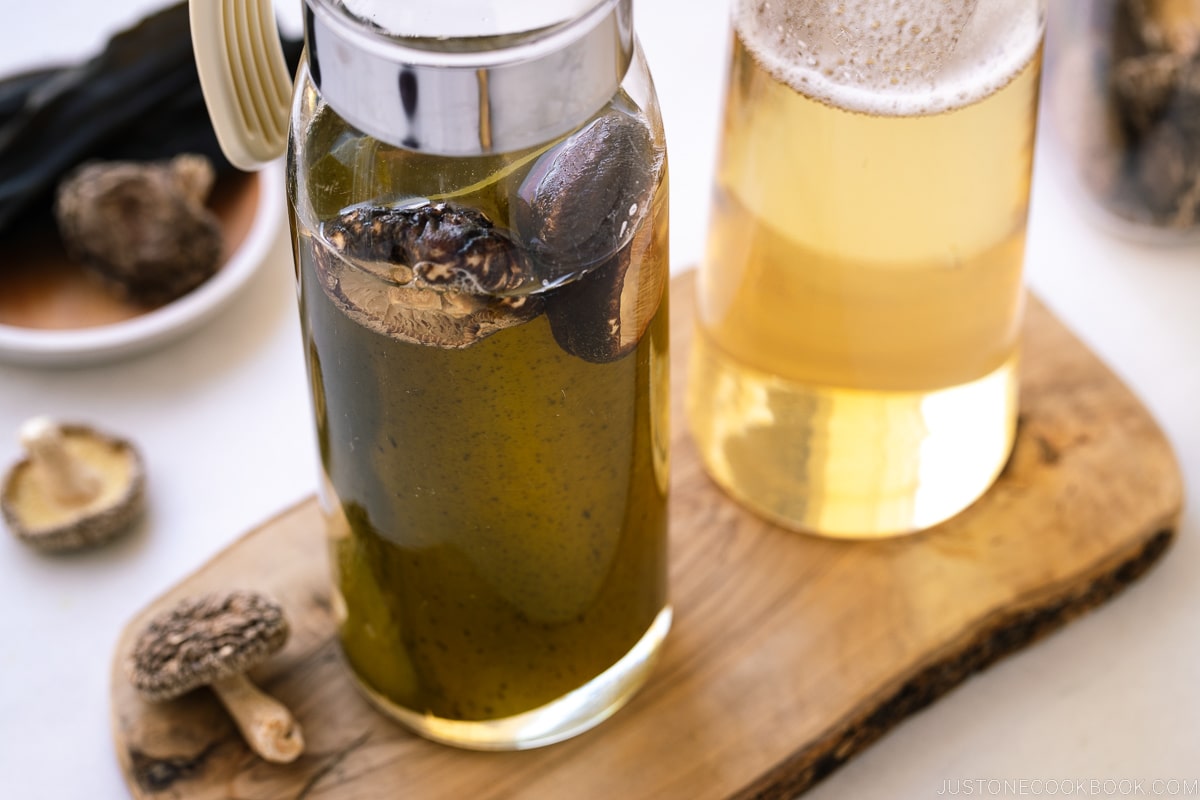
- Vegan dashi (精進だし) is a vegetarian/vegan stock made from rehydrating dried shiitake mushrooms and kombu (dried kelp).
- Rehydrated shiitake is used for cooking.
- It is more flavorful than Kombu Dashi.
? RECIPE: To make it from scratch, check out How To Make Vegan Dashi.
This stock is good for:
- Vegetarians and vegans who would like to make Japanese recipes that require dashi.
3 Ways to Make Dashi
Depending on your time and need, you can decide how to make Japanese soup stock using three ways. I’ll start from the most time-consuming method (but only 20 minutes!) to the instant method.
- Method 1: Make Dashi from Scratch (20 minutes)
- Method 2: Dashi Packet (5 minutes)
- Method 3: Dashi Powder (5 minutes)
Method 1: Make Dashi from Scratch
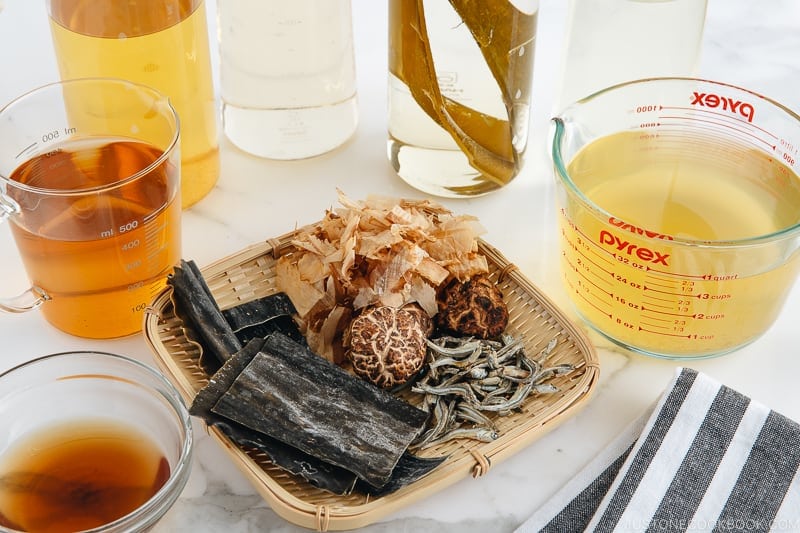
Once you decide what ingredient(s) you want to use for your dashi, please click the link to get the recipe.
- Kombu (dried kelp) + katsuobushi (dried bonito flakes) → Awase Dashi
- Kombu → Kombu Dashi
- Katsuobushi → Katsuo Dashi
- Iriko or niboshi (dried anchovies/sardines) → Iriko Dashi
- Dried shiitake mushrooms → Shiitake Dashi
- Dried shiitake mushrooms + kombu → Vegan Dashi
If you are not sure, go with Awase Dashi. If you’re vegetarian/vegan, go with Vegan Dashi.
Method 2: Dashi Packet (Shortcut)
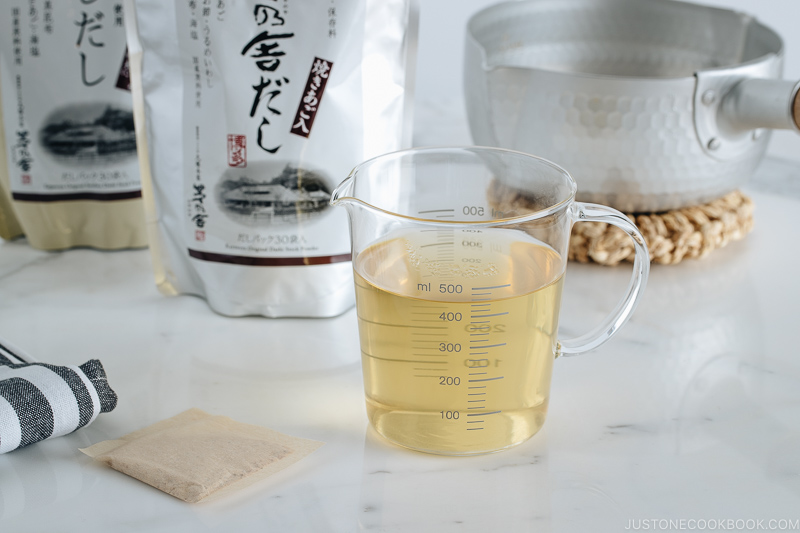
This is the most convenient method which produces pretty flavorful soup stock. One drawback is that these dashi packets might be hard to find in Asian grocery stores. Your local Japanese grocery stores should carry one or several brands.
The Dashi packet above is Japan’s most popular Kayanoya Dashi Packet (MSG-free & additive-free; a bit pricy; Amazon). You may also find Yamaki Dashi Packet in Japanese grocery stores or on Amazon.
? RECIPE: To make dashi using a dashi packet, check out Dashi Packet & Recipe.
Method 3: Dashi Powder (Shortcut)
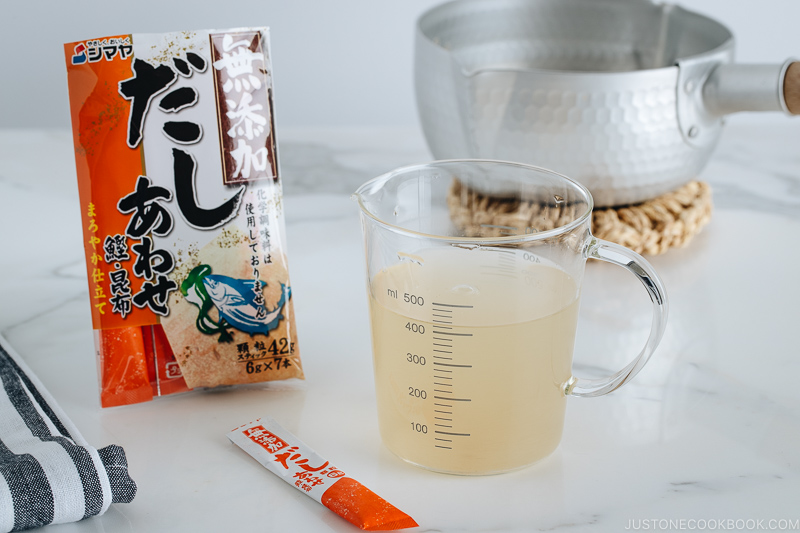
If you want to make a bowl of miso soup, instant dashi powder can be very convenient and save a lot of your time. The most commonly known products are Hondashi (ほんだし) and Dashinomoto (だしの素), which you can find in Asian or even American grocery stores.
However, I strongly recommend MSG-free & additive-free Dashi Powder that’s available at Japanese grocery stores or Amazon.
? RECIPE: To make dashi using dashi powder, check out Dashi Powder & Recipe.
Watch How to Make Dashi
I hope this ultimate dashi guide was helpful. Did you figure out which Japanese soup stock you want to use for your next meal?
Wish to learn more about Japanese cooking? Sign up for our free newsletter to receive cooking tips & recipe updates! And stay in touch with me on Facebook, Pinterest, YouTube, and Instagram.
Editor’s Note: This post was originally published on January 4, 2011. The images, video, and content have been updated, and the comment form is open in May 2019.


